

The 49 Techniques from Teach Like a Champion. The 49 Techniques from Teach Like a Champion. A great way to motivate and inspire your students!
Spiky or Soft – Protection and Connection. Perhaps self evident: When people are hurt or scared, we often protect ourselves by becoming spiky or hard – creating a shell or a wall.

As we shut down our feelings to prevent more distress, we shut down not just the painful feelings but all feelings. As the spikes get sharper, the walls higher, we shut out not just the source of threat but everyone else. In those times we have a choice — to be protected, isolated, and numb vs vulnerable, open, and vibrant. While the latter sounds more obviously rich, it’s not a trivial risk. When we “know” that the world is dangerous and people are “going to” hurt us, vulnerability isn’t an easy choice. The paradox is that no matter how sharp the spikes nor high the walls, we’ll never be safe that way.
What’s the first step? Related About the author - Joshua Freedman Joshua is one of the world’s preeminent experts on developing emotional intelligence to create positive change.
PLC. 122463-WhyArentTheyPayingAttentionHandouts. RESTAINTS AND SECLUSION. Affective Teacher Education: Exploring Connections Among Knowledge, Skills ... - Patrice R. LeBlanc, Nancy P. Gallavan. PASS: Postitive Approach to Student Success. Management system tools. Positive. Data. Glossary of Terms. Glossary Terms: Behavioral Intervention Behavioral Contracts.
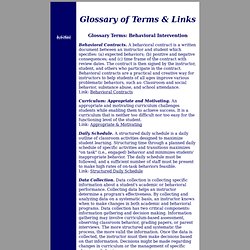
A behavioral contract is a written document between an instructor and student which specifies: (a) expected behaviors; (b) positive and negative consequences; and (c) time frame of the contract with review dates. The contract is then signed by the instructor, student, and others who participate in the contract. Behavioral contracts are a practical and creative way for instructors to help students of all ages improve various problematic behaviors, such as: Classroom and social behavior, substance abuse, and school attendance. Link: Behavioral Contracts Curriculum: Appropriate and Motivating.
Daily Schedule. Data Collection. Differential Reinforcement. Environmental Engineering. Functional Behavior Assessment. Group Reinforcement Response Contingency. Home Notes. Instructional Pacing. Parent Conference. Positive Reinforcement. Token. Info-Base Glossary. Antecedent An event that occurs prior to the target behavior.
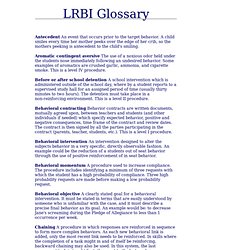
A child smiles every time her mother peeks over the edge of her crib, so the mothers peeking is antecedent to the child's smiling. Facilitating Social and Emotional Skills Through Tech. It all begins with relationship.
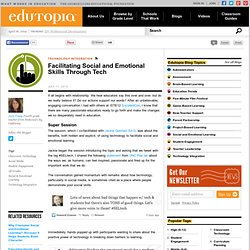
Overcorrection.
Integrated Emotions: Rethinking the way we evaluate our feelings. The Puzzle of Our Inner Landscape. Staying with feelings is like putting together a puzzle.

At first we sit in front of a jumbled mess. But puzzle makers trust that if they contemplate the pieces, they will begin to see patterns and how pieces fit together. Do you remember the feeling of sitting in front of a puzzle and suddenly understanding how the triangle filled with yellow and white fits into the whole? Working with emotions is the same, except that as we observe ourselves, we will have to tolerate both the confusion and the intensity of our feelings.
Building a puzzle is fun; feeling our anger, fear, or sadness—not much fun. Discerning our path—Emotions as an internal GPS. Despite all our technological advances, isn’t life still full of mystery?

One enigma is our emotional inconsistency. IMPACT_Classroom_Handout_2012. Self Regulation. Implementing Self-Regulation and Self-Monitoring in the Classroom What is Self-Regulation?

“Teachers, and particularly teachers of students with emotional/behavioral disorders, are increasingly faced with challenges, regarding the instruction and management of their students" Sutherland, 2002, p. 110). Singer and Bashir (1999) state in their article that self-regulation is considered a “meta” construct that is specifically defined as “a set of behaviors that are used flexibly to guide, monitor, and direct the success of one’s performance" Singer & Bashir, 1999, p.265).
The 49 Techniques from Teach Like a Champion. Attack mechanisms. Explanations > Behaviors > Coping > Attack Mechanisms Description | Example | Discussion | So what?
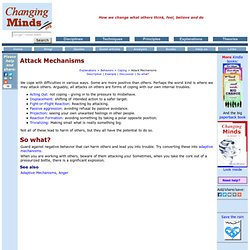
We cope with difficulties in various ways. Some are more positive than others. Perhaps the worst kind is where we may attack others. CoachesToolkit2007.
Reducing%20Behavior%20Problems%20in%20Elementary%20School%20Classroom. Resources for Teachers. These web pages contain very useful material to assist your efforts in educating for character.

There is a lot in this list that you can use as the basis for class discussions, writing assignments and student activities. We have not attempted to sort them according to the virtues they teach because they all teach many virtues. The Random Acts of Kindness Foundation www.actsofkindness.org This website is just packed with great stuff for propagating basic human kindness. Their own description is way too modest, but here it is: "Want to encourage kindness on campus?
Access our free Teacher’s Guide, lesson plans, activity ideas, teachers’ experiences, and other materials to help you successfully incorporate kindness into your school. " 5 Pro-Active Strategies. What’s Here The key to managing student behavior has nothing to do with tangible rewards.
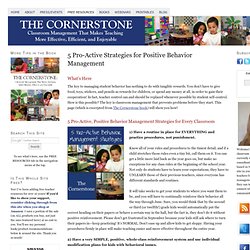
You don’t have to give food, toys, stickers, and pencils as rewards for children, or spend any money at all, in order to gain their cooperation! In fact, teacher control can and should be replaced whenever possible by student self-control. Emotions. Explanations > Emotions So what? | See also Emotions are our feelings. Literally. Fight-or-Flight Reaction. Explanations > Brain > Fight-or-Flight Reaction Physical changes | Modern effects | Freezing | And... | So what?
Attack mechanisms.